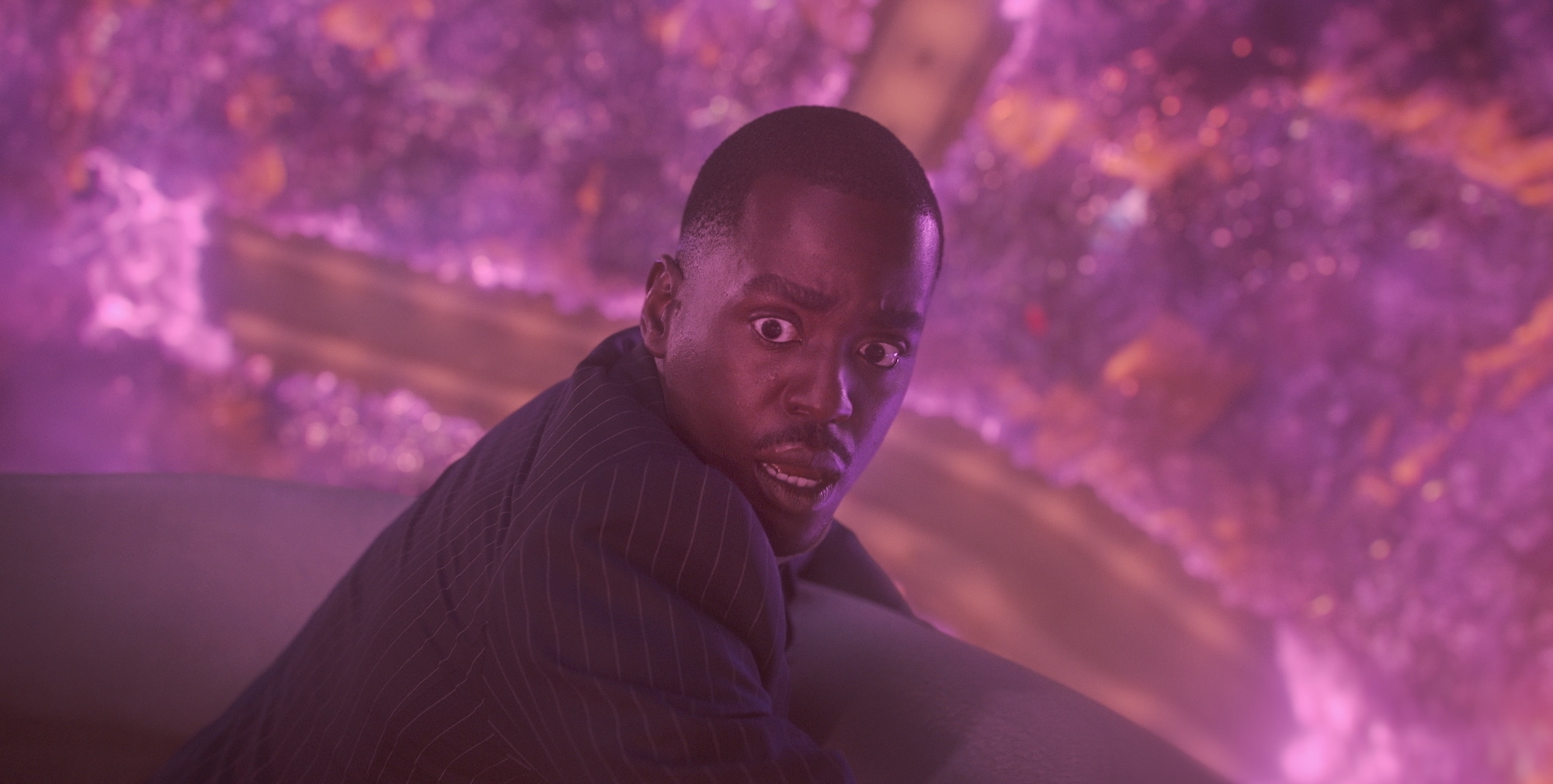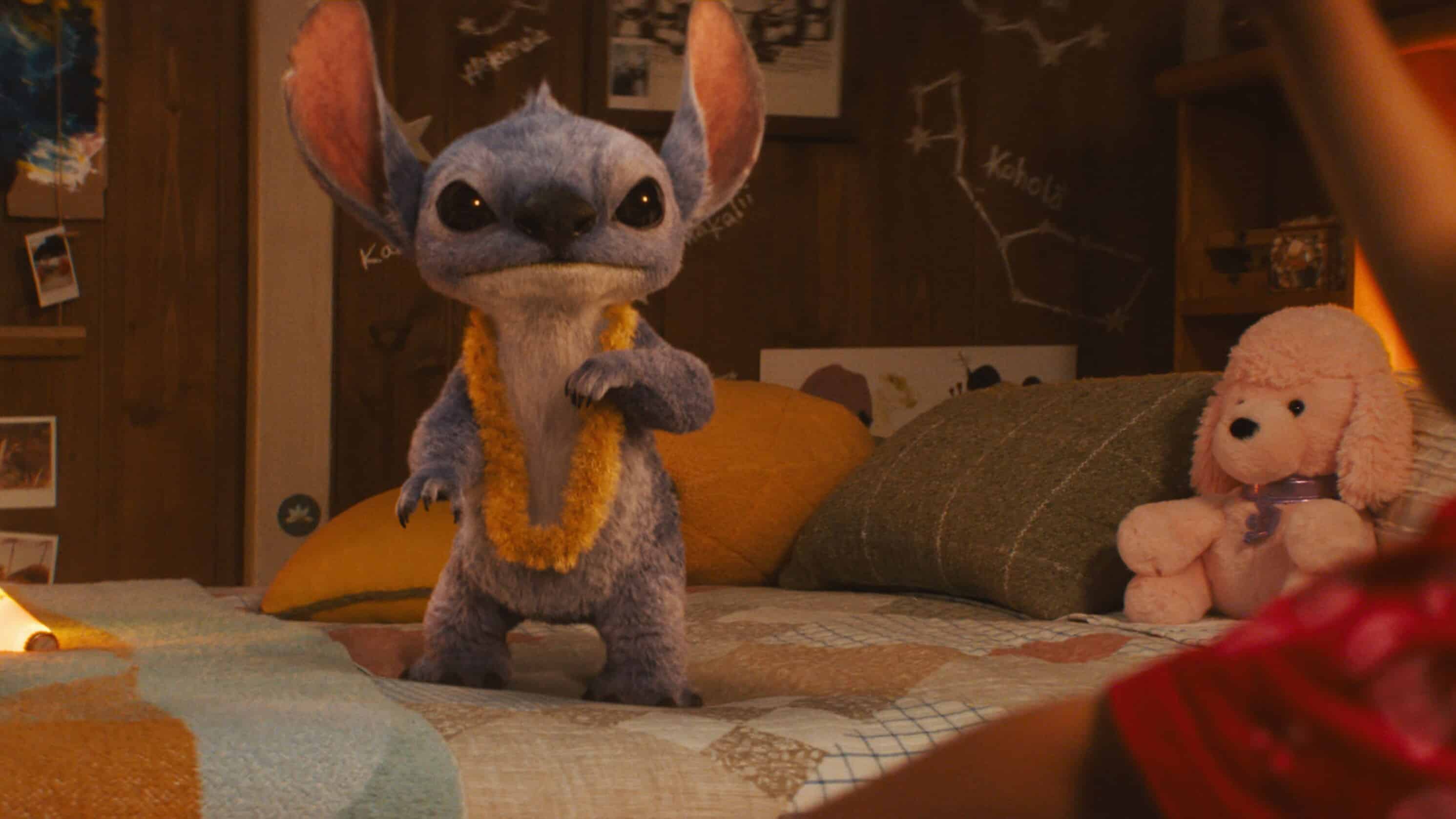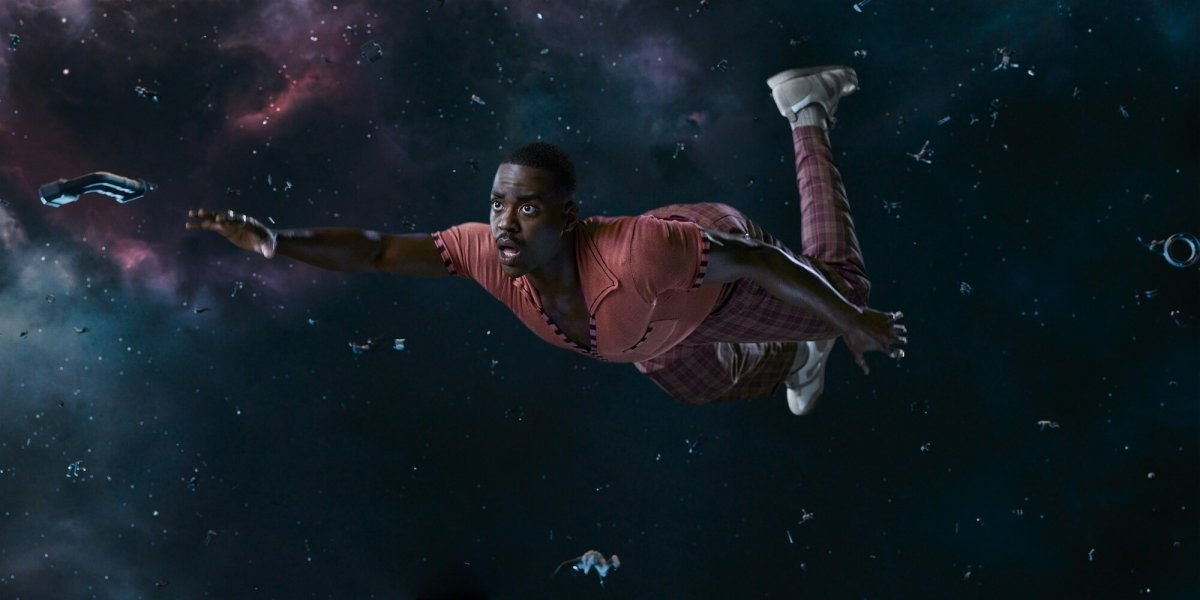The quest to get Belinda home leads to an abandoned cinema hiding a terrifying secret in Disney’s Doctor Who Season 2, Episode 2, “Lux.”
Armaan Babu: If Doctor Who has taught us anything, it’s that it’s not so fun exploring all of space and time without a companion to help you through it. For this series of reviews, I’m volunteering to join Margot Waldman for the ride!
Margot Waldman: I don’t feel qualified to be the Doctor in this analogy – I’m American! But I like where you’re going with this. So maybe we can be a Sarah Jane Adventures situation? I’d really be much more comfortable as K-9, to be honest. You can be K-9 and I can be Sarah Jane, maybe!
Or what about Class – does anyone but me remember Class? Well, I guess I don’t remember the names of any of the characters in Class. Oh! There was a girl who became a lava monster in the finale, I remember that.
Armaan: I’m sorry, no one told me lava monster was an option, I’m calling dibs!
Midnight Screening
Armaan: The episode starts with the Doctor and new companion Belinda Chandra, as part of their quest to make it back to May 2025, taking a first step to Florida in 1952. It’s a golden age of cheap popcorn, black-and-white movies, unapologetic racism and fourth-wall breaking cartoons (voiced by Alan Cumming) that are trying to kill you.
OK, one of those things doesn’t belong, and sadly it’s not the unapologetic racism.
Margot: “Dot and Bubble,” which was all about the racialized notions fundamentally baked into a show from 1963 about saving plucky white people with RADA degrees, was my favorite episode of last season, because it had a cohesive message about race. But “Lux” – an episode I liked! – had nothing like that. So not to contradict you, but I think the problem might be that the unapologetic racism really doesn’t belong here – despite it being the Florida of the days of Stetson Kennedy, who (according to legend, anyways) used not light but sound in the Superman radio show to expose the secrets of the Klan. (This story was recently adapted into the wonderful Superman Smashes the Klan by Gene Luen Yang and Gurihiru!)
I think the semiotics of a Black Doctor are something Davies has been really, really invested in, and I commend it. You have to honestly engage with what your casting means – and as much as I respect and obviously agree with race-blind casting’s message that the past was not lily white, Bridgerton for me can never get around what Jane Austen herself knew – that these cotillions and balls were funded by slavery and oppression. But those semiotics, the simple fact of Ncuti Gatwa and Varada Sethu looking the way they do and being who they are, are never quite given the space they need. Racism is a theme never quite committed to.
Armaan: The thing about old school cartoons is that they committed. They overcommitted, even, and that’s what made them work. This episode, however, can’t seem to commit to anything at all, and as such it’s less than the sum of its disparate parts. We have a lot that’s happening. A cartoon villain who is an avatar for a much more dangerous cosmic being. The Doctor coming face to face with segregation. The fourth-wall breaking fans, the heartbreak of Mr. Pye’s wife coming so briefly back to life, and the first steps of a new companion coming to understand just how complicated the Doctor’s life is.
A lot of different elements, very few of them quite landing — and almost none of them tying together in a satisfying way by the end.
Margot: I liked this episode more than you did because a lot of the other elements fit together satisfyingly, but 1952 really is too big a piece of the jigsaw puzzle to fit snugly. There’s no reason this couldn’t have been a revival theater in modern-day London, right? And what does it actually mean when the Doctor says that he sometimes must simply “wait for people to topple the world” – and that until that day, his purview as a time traveller is to live and “shine” in the past. It’s certainly better than “Rosa” – but it’s clumsy all the same, especially since every other character in the 1952 setting is an aw-shucks white person with a shakily American accent (who knew Florida was populated by three people?). So I just don’t know.
Armaan: It has the hallmarks of writing that wants to say something but doesn’t quite know what to say. There are hopeful platitudes, but there’s no real grappling with the concept either. The most you can really take away from the episode in regards to segregation is A) golly, it did kind of suck, didn’t it? and B) there is perhaps some strength to be found in trying to be your best self anyway — but it does help to have a vehicle that can take you away from it all.
Margot: That being said, I was impressed by a lot of the other elements of the episode – even if the villains of the piece, Mr. Ring-a-Ding and systemic racism, were not exactly among them.
Turn Down the Lights
Armaan: I don’t know about you, but I find that for most Doctor Who episodes, it takes me a while before it settles on me and I can tell how much I’m going to enjoy it.
This season so far hasn’t been afraid to take its time to get to the point. There’s a lot I enjoyed about the first chunk of this. The promise of a cartoon come to life intrigued me. The costumes and sets were all delightful. Most importantly, though, I’m really enjoying seeing the Doctor and Belinda on screen together.
Ncuti Gatwa is, of course, endlessly charismatic
Margot: Oh my god yes. Oh MY GOD YES.
Armaan: He brings such an infectious enthusiasm to everything he does. Varada Sethu’s Belinda, in contrast, is walking a very fine line. She’s bringing out that sense of wonder that early companions have, while at the same time able to be a bit of a wet blanket for some of the sillier bits of the mythos — not in a way that belittles it, because nothing is dimming this Doctor’s light, but in a way that lets us laugh at things that are objectively silly.
Margot: Ever since this new series has started, I keep thinking of Grant Morrison. Like I said in my first review, RTD’s approach has always been enormously influenced by British comics – “Bad Wolf” could easily be a lost Alan Moore bit. Now, RTD is in a Morrisonian mode, where continuity (especially deep, deep, obscure continuity) is something to be celebrated. Because this is his second time around, because he understands the show so much, in this new era for Davies, metafiction and formalistic experimentation have become yet another land for the Doctor to explore – like in a Morrison comic. But not so much Animal Man Morrison though – it’s weird, late Morrison, where the 21st century is here and has started to reek. It’s more like Superman and the Authority or something. It’s so, so weird sometimes.
Armaan: Disney’s Doctor Who does bring a lot of intriguing concepts to the table, but it’s just as willing to walk away from them as well. The Doctor is not a person given to lingering, and there are a lot of fascinating concepts that come up in the series that aren’t examined as closely as they could be.
In parts, that’s worked in the show’s favor — quick, episodic stories just as quickly moved on from keep the show so very accessible, and that is, at the end of the day, what keeps it fun. However, it also means a lot of great ideas only ever get to be just that — ideas, fleeting, thrown away before their impact can be felt.
That said, a chance to examine a show’s metafiction is always going to hook certain audiences. Critics especially.
Margot: Wow, how dare you, haha! But I do take your point – we’re broad but not deep here. Even the implications of the last season are kind of skimmed over – the episode goes so far as to helpfully remind a forgetful viewer what happened last season, through little flashback clips of the Toymaker, the Maestro and Sue Tech himself.
But for as long as it lasts, I loved the metafiction – I always have and always will! First our heroes are trapped in a cartoon (one wonders if this happened to the poor Shalka Doctor) and rendered flat and two-dimensional, seemingly trapped by the same rules of cartoons that take Lux Imperator from the “glint in the eyes of the mad” to a little weirdo forced to reenact his dumb introductory number.
Armaan: This is where the episode started going downhill for me. Cute as it was to see the Doctor and Belinda as cartoons, the concept of becoming 3D again by developing more depth kind of backfired — there is very little depth to their relationship right now, and in all honesty, to the both of them as characters.
Despite this being the show’s second season, it feels like we’ve barely scratched the surface with this Doctor. Shorter seasons have given him very little time to breathe, very little space to explore what makes him tick. Gatwa’s performance is what sets this Doctor apart, and as we keep getting more and more episodes, there needs to be more.
Even the issues Belinda and the Doctor talk to each other about — we’re barely scratching the surface of how complicated their situation is. We’re getting glimpses of something more, and this scene in particular felt like the series is uninterested in truly going much farther beyond those glimpses.
Margot: I hear that, and I can’t entirely disagree, but I get the sense the show sees that, too. It literally starts kicking and tearing at the edges, the limitations, of the screen in this episode. And so the Doctor and Belinda eventually escape Florida for uh, Armaan and I discussing this episode – that is to say to 2025, where some Doctor Who fans are watching this episode and snarkily reviewing it – which makes me feel pretty weird reviewing it, because I am in this episode. I mean, I would wear the Telos shirt Lizzie (I think it’s Lizzie?) is wearing. They should sell them because I’d buy one.
This is what I mean by the Morrisonian aspect – like in Superman and the Authority, where the team fights, uh, internet criticism and it’s sort of a way to make fun of people who don’t really like Grant Morrison comics. Here, the Doctor and Belinda get help from you, the viewer, as you criticize the way RTD plots Doctor Who. As we quickly learn, these fans are “real” but not really real – they’re still toys and tools of Lux, just as much a narrative trap as gritty reality in 1952 would have been. But the fans – Lizzie, Hassan and Robyn (the kind of characters, we’re told, who never get last names, because they don’t matter in the way someone like Belinda does) are able to tell the Doctor the grammar of his own world, because to them, he’s fiction – and to him, they’re fiction. And then, like that, they’re gone – or so we think.
Armaan: Yes, for me, this was a part of the episode that either needed to be longer or much, much shorter.
For a show that thrives on glimpses and throwaway ideas, there are a lot of moments that shine despite how brief they are. Last episode, for instance, was full of such moments. The rebel who died before we really got to know her, the implications of what life under AL must have been like, the peeks of loneliness into his heart. Those fleeting moments work because we as an audience are trusted to find our own fascinations where they present themselves. These moments are prompts for our imaginations, to run with as we see fit, passively collaborating with us to deepen a story’s impact.
The moment with the fans, however … it was clear the show wanted us to feel a certain way. The music swelled as the fans prepared to say goodbye. Their pleas to be remembered, their message about how the Doctor made them feel dragged on for far longer than was necessary. This episode wanted to celebrate its fans but in execution tried too hard in a way that, again, backfired against its intent. It feels disingenuous.
Margot: I thought it was sly and maybe a little mocking, but I don’t know if it was disingenuous. More just honest – we are a pretty harsh fan community (as this review goes to show)! I can’t say, though, that it wasn’t a bit too much or too little. Thematically, it could work, maybe – there’s some connection there to widower Mr Pye’s living vicariously in the onscreen light with his wife – but it never quite comes together.
Armaan: Agreed, which is tragic, because Mr. Pye’s conviction that his wife is real, the merit of that argument, and the heartbreak that comes with the entire situation was one of the strongest parts of this episode.
Margot: I suppose it’s something like light (not narrative, though) bringing people together as opposed to making people feel smaller – in between preferring the original RTD era, the three Whovians gush about meeting their best friends through the show. It’s quite a nice message, honestly – it’s just hard to review because I don’t know where it really belongs. It’s like the episode briefly interspersed part of the first, good half of “Love and Monsters” into what I suppose should be a fight with Cuphead – I mean, Mr. Ring-a-Ding, who is just not much to write home about. Why shouldn’t we make him laugh again?
Armaan: I’ll say this much: He certainly didn’t make us laugh.
I was honestly relieved when he was gone. For an otherworldly cosmic god of light, he was embarrassingly easy to deal with. When you can deal with a member of the Pantheon as easily as you can deal with a low-level vampire, the stakes are not as high as you want them to be.
As a cartoon and as an alleged god, Lux was a real missed opportunity.
Final Thoughts
Margot: I liked this episode better than the last one, but it’s not exactly cleanly put together. I loved the metafiction (I always love metafiction), and I honestly did love seeing the Doctor and Belinda communicate healthily to become better-formed characters. It really makes a difference from the Martha era – though “Blink” is probably still better.
Armaan: That is interesting to me, because I personally enjoyed the last episode a lot better myself. It knew what it was trying to be, it knew when to be amusing, when not to be, how to make a villain you’d love to hate — and how to make you glad to find a better way forward, nonetheless.
This episode, in contrast, was a mess. A lot of ideas were thrown in, and almost nothing resolved itself in a satisfactory manner. The Doctor and Belinda work well together, and are growing closer in a way that feels earned, but everything else in this episode feels rushed and half-baked.
Every season of Doctor Who has its dips, but as many fans have pointed out, the series’ limited runs means that when an episode doesn’t work, it takes away so much more from the limited time we have with this Doctor.
It’s about time we start getting a little more depth. The Doctor’s starting to feel a little two-dimensional, and we deserve more than just glimpses into something more.
Margot: I wish we had more than eight episodes, I really do. But if we only have eight, then maybe they have to be overstuffed – they have to be messy. I’ll say one thing, I’ll be here next week for “The Well.”
Armaan: As will I. Possibly as a lava creature!







